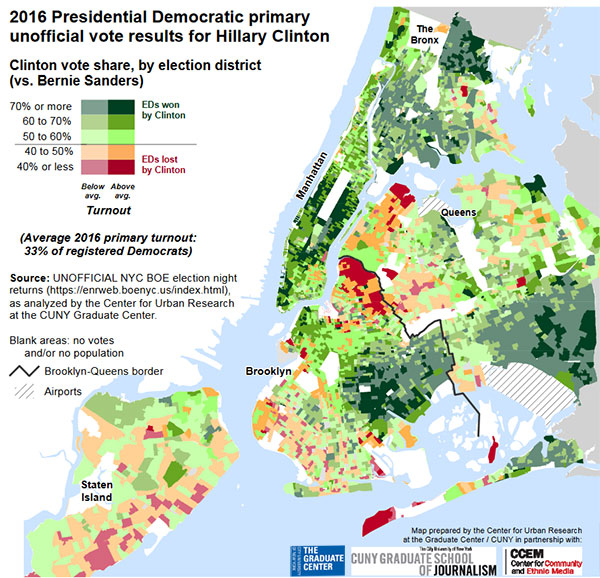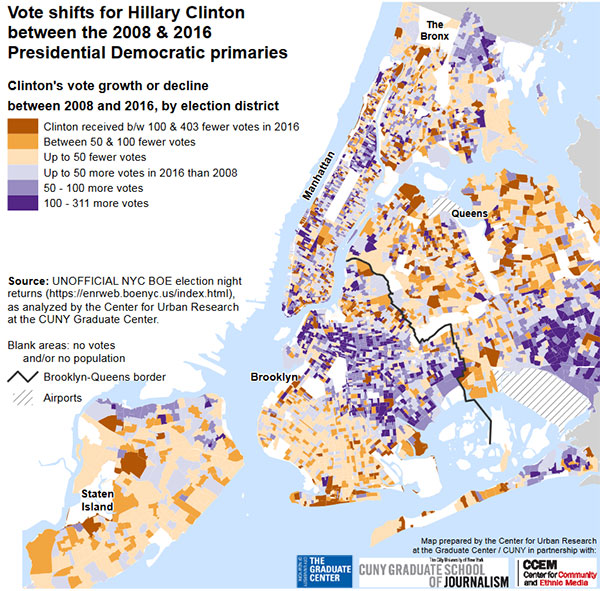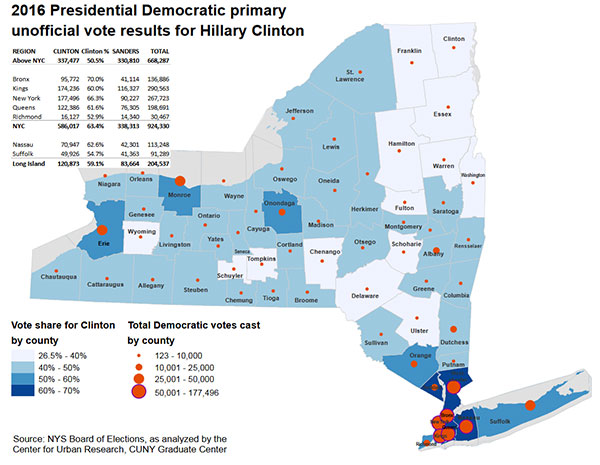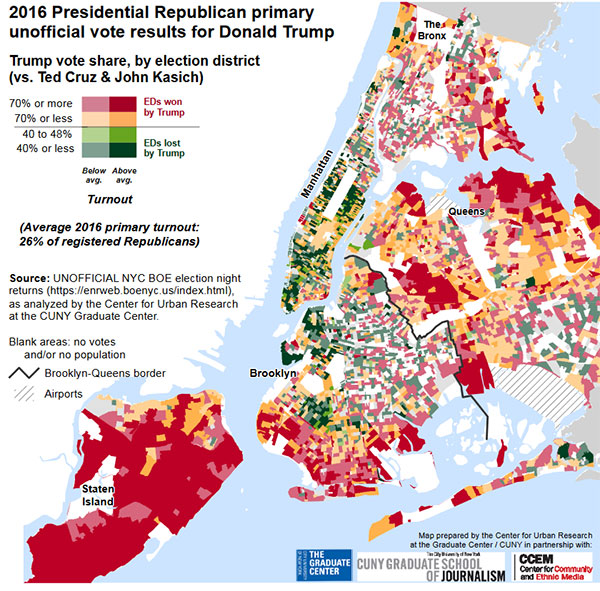Lobbying, in Albany, for Better Voting Laws
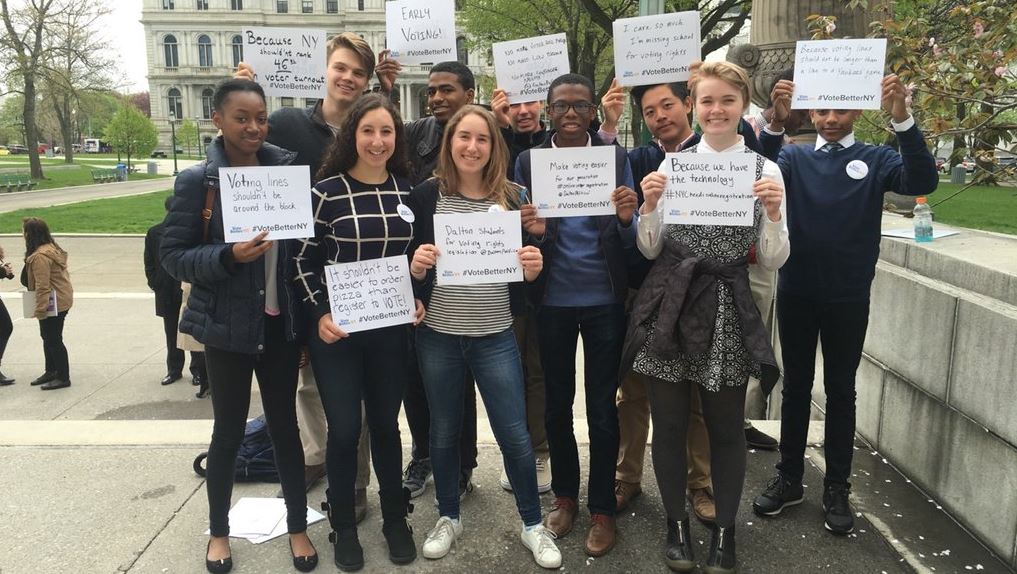
Students in Albany to lobby for voting and registration reform (#VoteBetterNY)
Before dawn on a cold and rainy May morning, about 175 New Yorkers gathered outside a building on Church Street, waiting to board a bus to Albany. Some had left their Staten Island and Queens homes as early as 4 a.m. to make departure on time, others had taken the day off work or school, all were there for the same reason: to meet with state lawmakers and convince them to modernize New York’s antiquated election laws.
Four buses pulled into the state capital a few hours later and members of the Vote Better NY coalition lined up on the stairs of West Capitol Park, behind the New York State Capitol Building, for a rally calling for passage of legislation to enact early voting, automatic voter registration, and better ballot design. These reforms, advocates say, would help to increase New York’s dismal voter turnout by making it far easier for New Yorkers to register to vote and to cast their ballots.
The May 3 trip to Albany, the rally, and the 74 meetings with legislators and the governor’s office scheduled for the day were organized by NYC Votes, the non-partisan voter engagement campaign of the New York City Campaign Finance Board. Tuesday marked the third annual NYC Votes lobby day, wherein New York City residents head north to Albany by the busload to push for voting reform, and the delegation has nearly doubled in size since last year when about 100 people attended, up from about 50 the first year.
“We still vote like it’s the 19th century and voters are sick and tired of election laws designed to benefit elected officials, rather than the voters,” said Onida Coward Mayers, director of voter assistance at NYC Votes.
“You know how they say, ‘there’s an app for that’? Well, there’s an act for that,” Mayers said, referring to the Voter Empowerment Act, a voting reform bill package that would expand online registration, allow certain government agencies to automatically register citizens to vote, extend party change and registration deadlines, and permit pre-registration for 16- and 17-year-olds. “Voters in 37 other states have early voting,” Mayers added, “Why not New York?”
The Vote Better NY coalition was joined for its rally by two state Assembly members and four state Senators, all of whom have either introduced or sponsored voting reform bills supported by the coalition, some of which have passed in the Democratic-controlled Assembly for years, only to die every time in the Republican-led Senate. The exclusively Democratic group of lawmakers present at the rally made their support for voting reform clear as ever, and repeatedly expressed exasperation at the lack of support for such reforms from their colleagues “across the aisle,” creating a situation where those who profess their support for voting reform offload all of the blame for the lack of movement on the reforms onto those who do not support the legislation.
“We get it, we are sponsoring these bills, we have been trying to get [reform] through for years,” said Senate Democratic Leader Andrea Stewart-Cousins. “The last time we were able to do something significant [on voting reform] was when Democrats had the [Senate] majority.”
There has been record turnout in nearly every state that has voted in primary elections so far in the presidential race, Senator Michael Gianaris said, except New York. The Empire State has the second lowest turnout rate of any state so far this year, with just 19.7 percent of the voting eligible population casting a ballot. “All these other states, where they’ve enacted these reforms, have record turnout. The answers are simple, they’re staring us in the face,” Gianaris said.
“Why is it so hard to do something that should be so easy?” Gianaris asked, referring to getting these “common-sense” voting reforms passed. “Because there’s a lot of people in that building who want fewer people to vote because it benefits them winning,” Gianaris said, gesturing toward the collection of government buildings in the Empire State Plaza.
While it’s true that many Senate Republicans either don’t support or outright oppose many of the voting reform bills that have been introduced time and again in Albany, as Democratic Senator Brad Hoylman said when pressed to specify who was “standing in the way” of these reforms becoming law, “It’s important that everyone here get the Senators and Assembly members on the record as to whether they oppose or support extending the franchise…We can go to each Senator, Republican and Democrat, and ask them to cosponsor these bills.”
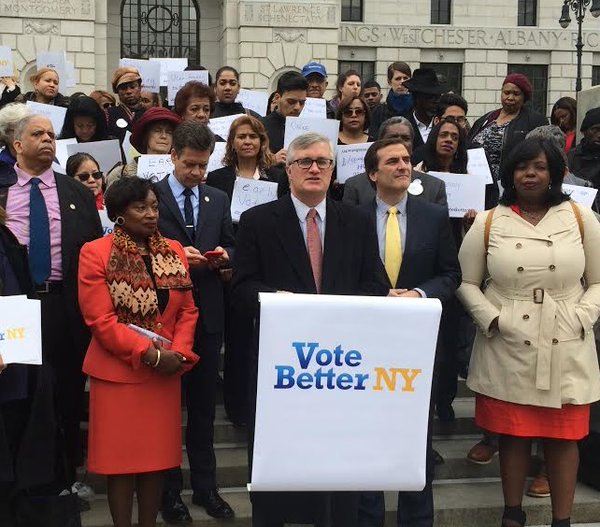 After the rally, members of the Vote Better NY coalition set out to change the minds of those not on board themselves, breaking off into groups of six or seven and heading into the labyrinth of the Legislative Office Building to meet with lawmakers. They were armed with messages of enfranchisement and efficiency, and checklists of legislators who have said they support early voting, the Voter Empowerment Act, and the Voter Friendly Ballot Act.
After the rally, members of the Vote Better NY coalition set out to change the minds of those not on board themselves, breaking off into groups of six or seven and heading into the labyrinth of the Legislative Office Building to meet with lawmakers. They were armed with messages of enfranchisement and efficiency, and checklists of legislators who have said they support early voting, the Voter Empowerment Act, and the Voter Friendly Ballot Act.
One group, made up of three members of the New York City Campaign Finance Board and three representatives from DYCD NYU Lutheran Family Health Centers, had their first meeting of the day with Senator Jeff Klein’s office. The meeting apparently went well, though Gotham Gazette can’t say for sure, as Dan Levin, assistant counsel to Klein, said their office “doesn’t do meetings with reporters,” and asked this reporter to wait outside, despite offers not to take any notes.
Members of the voting reform group expressed frustration with the fact that, though Klein’s counsel said the Senator is supportive of the voting reform bills, as leader of the Independent Democratic Conference, Klein could do more to get Senate Republicans to support such reforms. The IDC and Senate Republicans have a power-sharing agreement that gives the five-member IDC more sway than mainline Democrats, who are led by Stewart-Cousins. Klein has not signed on as a sponsor of any Vote Better NY bills.
After the meeting with Levin, the group left Klein’s office, heading toward a newly-booked meeting with Senator Andrew Lanza, a Staten Island Republican.
“They call this ‘the million dollar staircase,’” one aide from Klein’s office quipped as she walked past the group, “because they say it cost a million dollars.” The inside of the connected government buildings that spanned the Empire State Plaza are more ornate than their gray exteriors with dark, thin windows, let on - white marble spans the majority of the interior, the "million dollar staircase" that actually ran over its million dollar budget, a part of a wall in the central hall with water cascading down it, a McDonald’s, and a Dunkin Donuts all inside the building’s winding halls.
After waiting just long enough for members of the group to become bored enough to flip through a copy of the New York Post lying on Lanza’s waiting room table in search of the tabloid’s Met Gala photos, the group’s captain and the CFB’s public affairs officer, Amanda Melillo, was told that Lanza would be free later on, and to come back any time. (When the group returned about an hour later, Melillo was told that the senator was busy and instructed to leave some material for Lanza to read).
The group wound back through the halls, stairs, elevators, and escalators of the disorienting Legislative Office Building and its connecting tunnels to their next meeting, with Senator Simcha Felder. The Brooklyn senator is perhaps the most important person determining the upper house’s balance of power - he’s elected as a Democrat but caucuses with Republicans, and has recently created a 32-member majority in the 63-seat chamber.
“Oh, I’m sorry, I was teaching him how to tap dance,” said an aide who stopped striking the floor with her foot and moved to stand behind the main desk in Felder’s waiting room upon the group’s arrival.
Though the group was scheduled to meet with Felder himself in about ten minutes, with his tap dancing lesson cut short, Robert Farley, senior counsel in the New York State Senate, offered to meet with the group right away instead.
Gotham Gazette remained for this meeting, which lasted about 15 minutes. Throughout the discussion, Farley expressed skepticism, disapproval, or outright rejection of every voting reform put forth by the group.
Melillo and others spoke about the many issues New York City voters encountered during the April 19 primary, including the fact that some 126,000 Democratic voters in Brooklyn had been removed from the voter rolls, and that many New Yorkers had showed up to the polls on election day, only to be told that they were not registered to vote and must sign an affidavit ballot instead.
“A lot of people think they’re registered and they’re not,” Farley said, generally dismissing the group’s assertion that many of these people were registered to vote and were unable to cast a regular ballot. The bills at hand would, in part, make it easier to register to vote.
One member of the group, Rosa Velez, told Farley that she had worked as a poll worker on several occasions, including during New York’s most recent primary, said she “had so many people cursing me out at the primary - it was so stressful, people would walk in and I would just hope their name was on the list.”
“One woman who showed up to vote showed me on her phone that she was registered, but her name wasn’t on the list,” Velez added. “I told her she could fill out an affidavit, but she said, “no, f*** this, I’ve been voting for nine years, I want to vote the regular way.”
Melillo and Daniel Cho, director of candidate services at the CFB, then brought up online voter registration, and the potential of online and automatic voter registration to increase the number of registered voters and reduce the number of clerical errors made with the current mostly pen-and-paper system.
“Every time you do reform, there’s going to be problems,” Farley responded. “I don’t know how much doing another reform actually is going to change the problem, with people not doing their jobs right at the Board of Elections.” Farley added that electronic voter registration has its problems as well, citing the potential for hacking or voter fraud.
“I’m a tech guy, I love technology,” Farley said, gesturing un-ironically to the decade old desktop computers in his office, one of which was displaying bubbles bouncing around the screen. “But tech in and of itself can create more problems.”
Resigned, the group brought up New York’s closed primaries and early party change deadlines (New York is the only state where the deadline to change one’s party does not even fall within the same calendar year as the primary). Farley also didn’t believe open primaries or a later party change date would benefit New Yorkers, citing concerns of voters switching parties to game an election by voting against a candidate they didn’t like.
When early voting was brought up, Farley said “We do have early voting, we have absentee voting,” and dismissed assertions that absentee voting in New York requires an excuse. “The BOE never checks,” he said.
Somewhat dismayed by Farley’s lack of receptiveness to any of the voting reforms Vote Better NY was there to promote, the group headed to meet with Jacob Wilkinson, counsel to Senator David Valesky, a Syracuse-area Democrat. Wilkinson was more open to hearing what members of CFB and DYCD NYU Lutheran Family Health Centers had to say, taking a photo with the group and expressing support for early voting, though he shared some of Farley’s reservations about open primaries. “The restrictions on voting are a little silly and backwards, except open primaries, that’s a different story,” Wilkinson said.
Before heading out, the Vote Better NY coalition delivered a petition for reform signed by more than 6,500 New Yorkers to Governor Andrew Cuomo, Assembly Speaker Carl Heastie, and Senate Majority Leader John Flanagan.
Melillo says Vote Better NY branched out in terms of the legislators they sought to meet with this year, including more upstate representatives like Valesky.
Eric Friedman, assistant executive director for public affairs at the CFB, was part of the group that met with staff to Flanagan, Cuomo, and Heastie. He said that Flanagan’s staff had expressed reservations similar to those Farley had about passing voting reform - namely, concerns about the cost, whether they would be unfunded mandates, and questions about potential for voter fraud.
After meeting with lawmakers, those who had come along with the Vote Better NY coalition boarded their respective buses back to New York City around 4:30 in the afternoon, though the buses didn’t take off till about twenty minutes later, when a man carrying several pizza boxes across West Capitol Park handed the food to Melillo and other NYC Votes members.
The voting reform advocates who went to Albany on Tuesday included members of good government groups like NYPIRG and the League of Women Voters, civic engagement groups like Dominicanos USA and Generation Citizen, students, fraternity and sorority chapters, engaged citizens, and other groups like the NAACP and the New York Immigration Coalition.
“At the end of the day,” Friedman said on the bus ride back, “you want there to be the same concern for folks who are shut out of the process” as there is for the cost of funding and implementing voting reform bills. “Making sure the election system works for everyone shouldn’t be a partisan issue,” he said.
“The system that we have in place works for the people in power,” Friedman continued, adding that sustained momentum is needed to make more modernized election laws a reality for New Yorkers.
It’s not enough for lawmakers who say they support voting reform to pass “a one house bill,” Friedman said, the question is, “are you going to make it a priority in that room, are you going to put it on the table?” referring to negotiating rooms.
The early voting bill active in the Assembly is sponsored by Assemblymember Brian Kavanagh, a Manhattan Democrat, and has seven Democratic co-sponsors. Early voting in the Senate is sponsored by Stewart-Cousins and co-sponsored by 16 other Democrats. No Republicans have signed on to either bill.
The Voter Empowerment Act active in the Assembly is sponsored by Kavanagh and co-sponsored by 17 other Democrats and one Independence Party member, Fred Thiele. The Voter Empowerment Act active in the Senate is sponsored by Gianaris and co-sponsored by 17 other Democrats. No Republicans have signed on to either bill.
The Voter Friendly Ballot Act active in the Assembly is sponsored by Kavanagh and co-sponsored by 20 Democrats. The Voter Friendly Ballot Act active in the Senate is sponsored by Tony Avella, a member of the IDC, and co-sponsored by three mainline Democrats. No Republicans have signed on to either bill.
With the most recent budget negotiated, lawmakers are now in the legislative session that runs until the middle of June. The entire state Legislature - 63 Senate and 150 Assembly seats - is up for election in the fall.
“The individual legislators need to stand up and support these bills as much as possible,” Friedman concluded as the bus came to a stop outside the CFB’s building on Church Street around 7 p.m.
***
by Meg O'Connor, Gotham Gazette
@megoconnor13 @GothamGazette
Note: this article has been corrected to list the accurate sponsorship numbers of the early voting, voter empowerment, and voter friendly ballot acts.
5 Things State Lawmakers Can Do To Prevent Another Silver
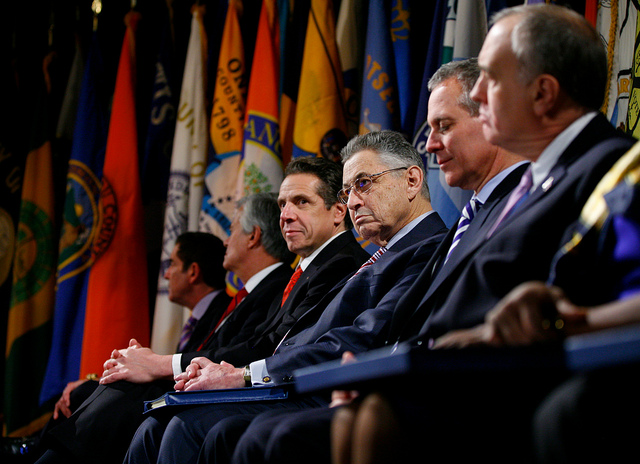
Silver, Cuomo, and others (photo via The Governor's Office, 2013)
Former Assembly Speaker Sheldon Silver was perceived by many to be an institution of state government. Having served at the head of the Democrat-controlled Assembly for over a decade, Silver’s rule was iron-fisted and opaque - he could end a political career on a whim, kill a major policy initiative with a quiet grumble, and maneuver millions of dollars in state cash to recipients of his choice.
That all ended last year when Silver was indicted by the U.S. Attorney on multiple corruption charges and voted out of leadership. For a few weeks he sat at a desk like a rank-and-file member of the chamber he once dominated. Even then some legislators thought there was a chance Silver would survive the scandal, but that was until he was convicted on all counts in late November. On Tuesday, Judge Valerie Caproni reminded Silver of the finality of his conviction, sentencing him to 12 years in prison, ordering him to pay back more than $5 million in ill-gotten riches, and fining him $1.75 million.
“I hope the sentence I impose on you will make other politicians think twice, until their better angels take over,” Judge Caproni told Silver. “Or, if there are no better angels, perhaps the fear of living out one’s golden years in an orange jumpsuit will keep them on the straight and narrow.”
As tough as Silver’s sentence might seem, there are a number of reformers that fear it is just another in a parade of sentences handed out to state legislators who violate the public trust and that without real reform politicians will be able to continue using their power to earn outside income that is tied to policy decisions, that they’ll be able to steer state funding to those they do business with.
Blair Horner of The New York Public Interest Research Group (NYPIRG) told reporters at a press conference a little more than an hour before Silver’s sentencing that he feared Gov. Andrew Cuomo and legislators will be content to act on only one reform measure this year: the first vote of two that is required to change the constitution so that lawmakers convicted of a felony are stripped of their state pensions. Both Silver and former Senate President Dean Skelos, also convicted late last year of public corruption, are set to receive hefty pensions.
“If that’s all they did they might as well not do anything,” said Horner. “You would think that going to prison would be a far more scary prospect than a loss of pension,” Horner said, noting that prison terms have not yet proven to be a real deterrent. Silver is joining a long list of former New York legislators to serve prison time.
NYPIRG and other government reform groups including Common Cause NY, Citizens Union, League of Women Voters NYS, and Reinvent Albany held simultaneous news conferences in Albany and New York City on Tuesday to call on lawmakers to act to prevent corruption in state government. They released a list of five reforms they want to see enacted immediately.
Good government leaders and reform-minded legislators say that the Legislature needs to take action to focus on preventing crimes instead of worrying about how to punish legislators once they have already been committed.
“What we want today are preventive measures,” said Laura Ladd Bierman of League of Women Voters. Reformers are calling, she said, not for more punishments, but for “things that prevent [corruption] in the first place.”
On Tuesday, Democratic Senator Todd Kaminsky was sworn in after winning the special election to replace Skelos. Asked by reporters if he thought there would be any consequences to the recent ethics scandals, Kaminsky said he thought his election was one direct consequence.
“I think my election is one of those results of what happens when you don't get reforms. I took a seat that was held by the same party since I was in first grade,” said Kaminsky, himself a former federal prosecutor of public corruption who helped put crooked New York lawmakers behind bars. “Things don't change lightly, they change when there are big seismic changes and I think thats whats happening.”
Silver’s replacement, current Assembly Speaker Carl Heastie, struck a somber tone with reporters, but said that it was time for life to go on and that most state legislators are good, hard-working people, though there are always a few bad apples in every industry.
Later on Tuesday, Kaminsky issued a statement on Silver’s sentencing, saying “justice was served.”
“But the fight to clean up our government is far from over,” Kaminsky said. “Silver's sentencing should serve as a reminder that serious changes still need to be made in Albany. Our elected officials must act swiftly and strongly before the legislative session is over to put an end to the parade of corrupt politicians who have cut taxpayers out in our state for too long.”
Largely similar to the list put forth by reformers on Tuesday, here are five things lawmakers can do over the next few weeks to help limit corruption in New York:
1. Ban or Limit Outside Income
Gov. Andrew Cuomo’s 2016 budget proposal included a bill that would restrict lawmakers outside income to 15 percent of their legislative salaries, which are currently $79,500 per year, mirroring the Congressional model. Silver was convicted of receiving payments from a law firm for which the only service he provided was referring sufferers of a deadly form of cancer.
Silver steered state funding to a doctor who in turn provided Silver’s law firm with the name of Mesothelioma patients. The arrangement earned Silver over $3 million in referral fees.
A number of other legislators work or have worked as counsel to law firms that may have business pending before the state, others have worked as lobbyists or consultants. Backers of Cuomo’s plan and ones like it say that legislators’ first loyalty should be to the people of New York and not to an outside employer.
However, legislators complain that their annual salary is not adequate. A pay commission is currently considering raises for the Legislature and the executive branch.
The Assembly has advanced its own bill to limit legislators’ outside income to almost $70,000 annually, a number that represents about 90 percent of current legislative salaries.
Senate Republicans have balked at the idea of limiting outside income. Senate Majority Leader John Flanagan, who left his outside practice when he replaced Skelos last year, has said he opposes a ban or strict limits. Republican Senator John DeFrancisco has argued that a ban would dissuade well-qualified people from public service. “I think you’re eliminating a lot of good people in government,” DeFrancisco told State of Politics in January. “If anyone really thinks creating a professional politician is going to root out corruption, where that politician is required every two years to win an election, I don’t think that’s a road to any less corruption.”
Kaminsky disagrees. On Tuesday after his swearing in, he said, “To have both leaders of both houses convicted and not having moved on outside income is unconscionable. We’ve got 21 session days starting in about ten minutes, so let's get to it.”
2. Create Stronger Budget Oversight and Transparency
In a new report, Comptroller Thomas DiNapoli criticizes this year’s budget for relying on lump sum appropriations. Silver was able to tap into hundreds of thousands of dollars of those sums to provide support for the doctor who provided him with referrals. The funds are not subject to public scrutiny.
Good government groups want such lump sums either banned or included in a newly created database to track exactly who requests the cash, who ends up spending it, and how it is spent. A Citizens Union report recently revealed that the 2016-2017 budget contains $2.4 billion in lump-sum spending.
3. Confront Pay-to-Play
Entities with business before the state are also some of the biggest campaign contributors. Good government groups say it creates at the very least an appearance of an inherent conflict of interest wherein those who give the most end up with favorable legislation, state contracts, and business subsidies. New York City currently places very strict limits on campaign donations from anyone with business before the city as part of its public-matching program, which the state does not have.
In another part of his scheme, Silver encouraged real estate groups with business before the state to use a law firm he was connected to in exchange for kickbacks from the firm. Real estate interests are some of the biggest donors in the state and have been allowed to negotiate policy by Gov. Cuomo and the Legislature.
4. Close the LLC Loophole
Real estate and other groups have been able to game the state’s already lax campaign finance limits by using a loophole that allows the creation of mysterious limited liability corporations with the express purpose of donating to favored politicians. “We have the highest limits in the country of any state that has any and even those limits get circumvented,” said Horner.
Leonard Litwin - who had previously been the largest campaign donor in the state - described to prosecutors how he and his corporation, Glenwood Management Inc., used the system to get around contribution limits.
Richard Runes, a lobbyist overseeing Glenwood’s government relations, detailed the process during Silver’s trial, saying: “I would take the checks, and I would attach my business card to the check with a paper clip, put it in a 1200 Union Turnpike envelope, and deliver it to whichever campaign committee it was going to,” referring to Glenwood’s address.
5. Ethics Watchdog Independence
The Joint Commission on Public Ethics (JCOPE), tasked with policing lobbying and ethics in the state, is renowned for its opaqueness and lack of major action. The body is made up of legislative and gubernatorial appointees, and the three chairs it has had in its short existence have all served as aides to Gov. Cuomo (one of them even returned to Cuomo’s direct employment after leaving the body).
The commission has routinely been crippled by infighting, with legislative appointees calling for less influence from the governor’s office, and JCOPE largely conducts its business in secret. The appointees of both Silver and Skelos have lingered on after their bosses were convicted of public corruption.
“We need to have a much better enforcement mechanism,” said Horner. “The fact that JCOPE has been relegated to the sidelines shows the need for better enforcement. We shouldn't have to rely on the federal government to police the state. We don't want a group that is solely a creature of the Governor and Legislature.”
“JCOPE needs to be an open entity,” Horner added. “It’s a public ethics watchdog, we should know as much we can know about it within reason.”
***
by David King, Albany editor, Gotham Gazette
@DavidHowardKing @GothamGazette
Note: this article has been updated to reflect the two Tuesday news conferences and that a list of reforms was put forth.
Note: Gotham Gazette is an independent publication of Citizens Union Foundation, sister organization of Citizens Union.
Takeaways from New York Presidential Primary Voting
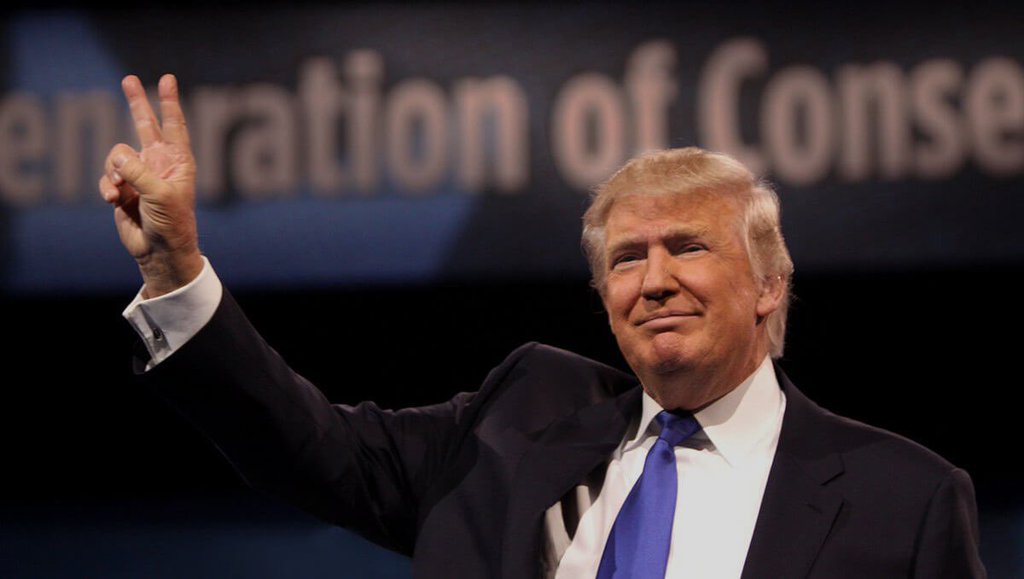
Donald Trump (photo: @realDonaldTrump)
In the 2016 New York presidential primary, Hillary Clinton won the greatest portion of New York City’s Democratic vote share by a better margin than pundits expected, substantially increasing her votes in predominantly black communities from 2008 and also receiving solid support from a number of traditionally white, liberal areas.
For Bernie Sanders, reports said he was trying to emulate the campaign that liberal upstart Zephyr Teachout ran in the 2014 gubernatorial primary, and expand the support she got in many of the small, rural areas that she did well in against incumbent Gov. Andrew Cuomo. Cuomo and Clinton are seen as of the same centrist wing of the Democratic Party. Sanders, who operates to the left of the party, was not extremely successful in expanding on Teachout’s support, but he did do well and even received a majority of votes in some surprising neighborhoods not known as liberal strongholds.
The primary, especially for Democrats, was decided along the lines of candidates’ institutional and grassroots support networks, and demographic voting patterns, both familiar and new. Clinton won very few counties outside of New York City, but in the city, where roughly half of all Democratic voters in the state reside, she won competently in most election districts. In areas of New York City where support for Sanders was strong, the margin of victory was often smaller, whichever candidate won.
There are over five million registered Democrats in the heavily blue state of New York, of which 2.76 million live in New York City according to the state Board of Elections. Roughly one-third of them, both state- and city-wide, turned up to the polls to vote on their party’s nominee for President. Secretary Clinton, who beat Senator Sanders with 58% of the state’s Democratic vote, did especially well in more urban areas, winning New York City and Long Island counties, as well as a few suburban counties just north of the city, but lost in almost every rural upstate county.
In the Republican primary, Donald Trump won all but one county statewide, receiving 60% of the 874,572 Republican ballots cast across the state. Of the close to 12 million registered New York voters, 3.2 million could not vote in either primary because of their enrollment status. Only registered Democrats and registered Republicans can vote in New York’s closed primaries, voters not registered in a party or registered with a party other than the two major ones were not eligible to vote.
In New York City, where John Kasich won Manhattan (New York County), the only county in the state that did not go to Trump, the number of Republican voters - 70,000, according to CUNY Graduate Center’s NYC Election Atlas - was nearly three times the GOP turnout of the 2012 primary. Still, close to one-third of the city’s 5,400 election districts saw fewer than five Republican voters at the polls. In almost 500 of them, no Republicans voted.
Clinton’s strongest support came from places with concentrations of middle- and upper-middle class New Yorkers, and in predominantly African-American and Afro-Caribbean neighborhoods, like the north Bronx and southeast Queens. She often received more votes in communities of color than she did in 2008 against now-President Barack Obama, even when the voter turnout was below the city-wide average this time around, according to CUNY.
Election maps provided by the WNYC Data News Team, indicate that Clinton’s two best neighborhoods in New York City in terms of the portion of the vote share she received were on the Upper East Side of Manhattan and Rugby-Remsen Village in central Brooklyn. East and central Brooklyn are areas that are predominantly African-American and Afro-Caribbean. While the primarily white, middle-class Upper East Side saw above average voter turnout, according to the NYC Election Atlas, the turnout in central Brooklyn was mixed and in east Brooklyn it was below the city-wide average turnout by Democrats per election district. Clinton won in those places by wide margins - at least 2:1 - despite the lower turnout.
The neighborhood where Sanders received the greatest majority of votes was Greenpoint, Brooklyn, where a larger percentage of Democrats showed up to vote than the city-wide average. Although Clinton received a higher number of votes there than she did in the 2008 primary, Sanders still won 63.8% of the vote share - his highest margin.
In Steinway in northwest Queens - another one of Sanders’ best areas by vote share, along with Breezy Point, parts of Bay Ridge, and the South Shore of Staten Island - Clinton received far fewer votes than she did in 2008.
In New York City, many of the places Sanders did well - Greenpoint, Astoria, Bay Ridge - are places that have seen or are beginning to see major demographic changes that come with gentrification. Especially in these areas, “hipsters” have become an emerging demographic of increasing political influence in elections.
“If you think about these as young people,” said David Birdsell, dean of the Baruch College School of Public Affairs, who studies city election trends, “somewhat more artistically inclined, somewhat more involved with gig economies, perhaps less likely to be employed by an organization that provides health insurance, perhaps closer to or still immersed in the experience of paying off college debt - there are lifestyle implications and there are time-of-their-life-cycle implications that suggest a set of experiences that would be consonant with and responsive to the Sanders message.”
Perhaps the biggest surprise was Sanders’ victories along the south shore of Staten Island, where 30,467 of the 119,328 registered Democrats there cast their ballots. Staten Island does not have an influential “hipster” demographic, nor a particularly strong liberal base. When asked about it, Steven Romalewski, director of the CUNY Mapping Service, responded, “Why?...I have no idea...I don’t even want to speculate. It’s just odd.”
In the Republican contest, Trump won 63% of the New York City vote share despite losing Manhattan, where Kasich received 45% of the 25,000 Republican votes. Trump’s best victories in the entire state were on Staten Island where he won 82% of the vote. He also did quite well in many predominantly white, conservatively-inclined communities in Queens, such as Middle Village and Howard Beach.
Statewide, Trump received a lot of voter support in the suburbs of New York, especially Suffolk County on Long Island. He also did well in the partially more-urban Erie County, home to Buffalo, where he had the endorsement of Carl Paladino, the high-profile businessperson who had strong backing from voters in western New York when he ran for Governor in 2010.
In the Democratic primary, Sanders won every upstate county above Orange and Westchester, except Erie, Monroe, and Onondaga, all of which have major cities where Clinton excels.
In New York City, Clinton also won large swaths of the northwest Bronx, southeast Queens, and east Brooklyn with over 70% of the vote share, all of which are predominantly African-American or Afro-Caribbean, and all of which saw below average turnout at the polls. In these areas, Clinton received more votes than she did in 2008, sometimes by triple digits, according to the CUNY election study, which is based on unofficial results provided by the city Board of Elections.
When asked why he thought Clinton received greater support from black voters than she had in the last Democratic presidential primary in New York, Romalewski told Gotham Gazette, “I think conventional wisdom is that...she was not running against Barack Obama, a historic African-American candidate, and in 2008 Barack Obama did very well in those areas - the only areas of the city she did not do well in.” It is likely, Romalewski said, that in 2008 there was “a strong connection between black communities and the black candidate. In 2016 that wasn’t the case.”
This, combined with the Clintons’ robust support from urban and black Democrats across the country, Romalewski said, is a plausible explanation of her new successes in those areas of the outer boroughs, even with the decrease in voter turnout. “So that’s one theory and probably the one that people tend to think of first off.”
“When you look at the patterns of where she picked up more votes between 2008 and 2016,” Romalewski said, “it also happened to be where Mayor de Blasio, or candidate de Blasio, in 2013 did well. And not just in predominantly black communities, but also in the Park Slope area and Clinton Hill and along the East River in Brooklyn, Brooklyn Heights, Cobble Hill, Carroll Gardens, those areas. So it’s possible that de Blasio’s endorsement of Clinton helped prompt more voters in those communities to support Clinton over Sanders.”
The south and central Bronx, largely Puerto Rican and Dominican areas, also saw a landslide Clinton victory with below average turnout.
In addition to being a group that Clinton has historically received strong support from, the active competition with Sanders may have forced her to make further commitments that resonated with Puerto Rican and other Latino voters. “She took a much stronger stand on Puerto Rico, when...she typically wouldn’t speak out against hedge fund people...That’s her crowd,” Theodore Hamm, chair of journalism at St. Joseph’s College and an open Sanders supporter, told Gotham Gazette. “Because Sanders was competing, [Clinton] was also forced to spend a lot more time...in New York City.”
Clinton’s visit to a NYCHA building in East Harlem with City Council Speaker Mark-Viverito just days before the primary, where she promised more funding for affordable housing, is another example of this. Following the visit, said Hamm, she made “commitments that she hadn’t made, that she probably wouldn’t have made without being challenged.”
Hamm believes the effect of the Sanders competition was positive, at least for the politicians embracing Clinton, who wanted to leverage their endorsement. The additional heat brought on by deep Sanders campaigning in the city “allowed Melissa Mark-Viverito and others to sort of step in and say, ‘OK well we’re gonna wholeheartedly support you, but then you gotta take a few stands that we want.’”
The strength of their support networks for both Democratic candidates was fundamental to the outcomes of the primary, even as the nature of their support differed greatly. Clinton owes part of her victory last week to returning, longtime supporters and the networks of politicians and political groups who ushered them to the polls - Clinton was, of course, a Senator from New York for eight years. Many of the places she did best, including her two strongest micro-areas - the Upper East Side and Rugby-Remsen Village - saw a relatively small increase in Democratic registrants who have not voted in a presidential primary before.
Calling the state a Clinton “stronghold,” Hamm said, “Clinton has been around for a while now in New York. She’s got pretty much all the Democratic politicians in her camp. They have their networks and they’ve turned out their voters, a lot of them older.”
While her political machine in New York allowed for a decisive victory last week, what that means for the future is completely unclear, Hamm believes. “I don’t know if she could do this again four years or eight years from now, or if someone who is sort of attaching themselves to the Clinton legacy, and so on, could pull this off. They would really need to get younger voters into the mix,” he said, referring to the fact that Sanders continues to dominate Clinton among young voters.
In the Sanders camp, support came from activist bases and on-the-ground networks. Part of his unexpected success in places like Bay Ridge and southwest Brooklyn is likely due to the strength of grassroots networks there. “I’m sure part of it had to do with the ground game,” said Romalewski. Almost in the next breath, however, he said, “I’m sure part of it had to do with New York City voters in some places being unpredictable.”
“There are definitely some political activist bases” in Bay Ridge, said Hamm on the subject, “Linda Sarsour, for example. Perhaps the Muslim vote was significant there - or helps explain that.” The demographic of voters in Bay Ridge, Hamm added, may also be more inclined to vote for Sanders than Clinton, even without pointed support from leaders like Sarsour, the executive director of the Arab American Association of New York. “Hillary actually won most of the low-income neighborhoods in the city, but most of them are predominantly black or Latino...This is a lower-income white and immigrant neighborhood now - Bay Ridge. There is not a large black population.”
But despite the get-out-the-vote efforts in Bay Ridge, neighboring communities in southwest Brooklyn saw turnout below the city-wide average and still went to Sanders. This may partially be explained by the growing number of young people in this area, who express support for Sanders, but many of whom are not registered Democrats.
“It’s so difficult to tell when the turnout is low,” said Birdsell, “and particularly when a neighborhood is in transition, as Bay Ridge clearly is right now - repopulating from an old-line, ethnic community to a relatively young-family, new-hipster neighborhood community.”
The influence of Sanders’ and Clinton’s support networks made central Harlem a closer battle than many would expect of the predominantly black area where Bill Clinton has had an office since the end of his presidency. Voters there went to the polls in greater numbers than other mostly black neighborhoods. In central Harlem, despite the Clinton victory, Sanders received relatively more votes than he did in other predominantly black areas of the city.
According to Romalewski, “part of this probably depends on local efforts, grassroots get-out-the-vote campaigns, local district leaders, that sort of thing.” The proportion of white residents in Harlem is also growing, which may have impacted the strength of Clinton’s support there. While demographic data from the last six years is inconclusive, the number of white residents in Central Harlem South quadrupled between 2000 and 2010, with white residents making up 16% of the population in 2010, according to the Census Bureau. Clinton still received a higher number of votes in central Harlem than she did in 2008.
For Republicans, the contest in Manhattan depended more on the affluent than on low- and moderate-income groups or people of color. Birdsell told Gotham Gazette, “This is sort of the home turf par excellence of silk-stocking Republicans of the old guard, and the corporatist Republicans of the perhaps not-quite-as-old a guard...and certainly not the pitchfork-waving loyalists of the Trump revolution.”
“So the notion that a candidate who presents himself as a more traditional corporatist Republican,” Birdsell continued, “who speaks more politely and talks about positive visions of the economy, even if at the end of the day the policies are, with certain signal exceptions, not strikingly different, that candidate is probably going to do better than someone who, despite being a millionaire and despite being involved in real estate of New York all his life, has hardly behaved like the discreet and genteel upper class that attracted that corner of the GOP.”
One of the only enclaves of Republican voters that supported Senator Ted Cruz in New York City was in the Orthodox Jewish communities of Brooklyn where he won some votes but no delegates. “He’s the most pro-Israel of all three,” Hamm said. “I don’t know that Kasich is distinct in that...But Trump said he would be a neutral negotiator [regarding Israel], and so if that’s your primary issue...then [Cruz] was the one to go for, right? Because he has been pandering to AIPAC and the Sheldon Adleson crowd.”
Suffolk County, which Trump won with over 72 percent of the vote, is another notable site for Republicans because of the diverse demographic makeup of its conservative voters. It is one of the largest counties by area in the country, ranging from rural to suburban landscapes, with some areas, especially on the north shore, having very high household incomes. Romalewski told Gotham Gazette that he noticed something “interesting” about a week before the primary: The number of students that opted-out of the Common Core tests in Suffolk County towns like Brookhaven and others was very high. “It really struck me. I noted on Twitter that...it would be interesting to compare how well this overlays with Trump’s vote support.”
“I think that’s an indication,” Romalewski went on, “of people fed-up with the system and, to the extent that they’re enrolled Republicans, that means they’ll likely vote for the candidate who says he’s fed-up with the system.”
The surprises that have come out of the New York presidential primary, Romalewski ruminated, are “one reason why we have elections and don’t just rely on polling.” On a broad scale pollsters and pundits may be relatively accurate, he went on, “but people, when they make their decisions, they’re making their own decisions...There are unexpected results that reflect reality and what some New Yorkers are thinking.”
***
by Ethan Geringer-Sameth, reporter, Gotham Gazette
@GeringerSameth @GothamGazette
